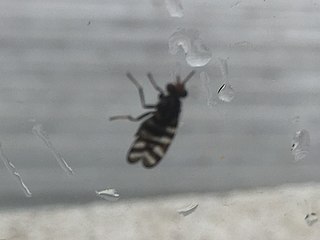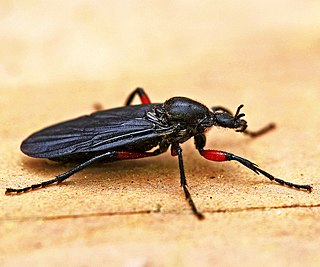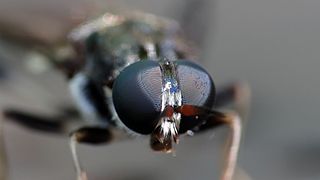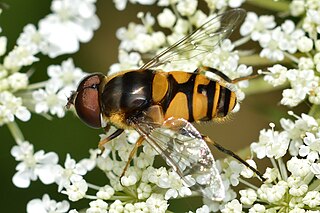Christian Rudolph Wilhelm Wiedemann was a German physician, historian, naturalist and entomologist. He is best known for his studies of world Diptera, but he also studied Hymenoptera and Coleoptera, although far less expertly.

The Asilidae are the robber fly family, also called assassin flies. They are powerfully built, bristly flies with a short, stout proboscis enclosing the sharp, sucking hypopharynx. The name "robber flies" reflects their expert predatory habits; they feed mainly or exclusively on other insects and, as a rule, they wait in ambush and catch their prey in flight.

Blepharotes is a genus of robber fly in the family Asilidae. Its members are found in Eastern Australia. They include the giant yellow robber fly Blepharotes coriarius, and B. splendidissimus.

Blepharotes coriarius, the giant yellow robber fly, is a species of large predatory fly from Australia in the family Asilidae. It was described by the German naturalist Christian Rudolph Wilhelm Wiedemann in 1830.
Neoeuantha is a genus of parasitic flies in the family Tachinidae.
Pyrrhodexia is a genus of flies in the family Tachinidae.

Xanthomelanodes is a genus of flies in the family Tachinidae.

Pterotaenia is a genus of picture-winged flies in the family Ulidiidae.

Bibio femoratus, also known as the March fly or lovebug, is a species of fly in the family Bibionidae. It was first described by the German entomologist Christian Rudolph Wilhelm Wiedemann in 1820.Bibio femoratus is one of at least 90 types of March flies, which occur in the United States and Canada.

Terellia serratulae is a species of tephritid or fruit flies in the family Tephritidae.

Exaireta is a genus of soldier flies in the family Stratiomyidae.

Eristalis transversa, the transverse banded drone fly, is a common species of syrphid fly first officially described by Wiedemann in 1830. Hoverflies get their names from the ability to remain nearly motionless while in flight. The adults are also known as flower flies for they are commonly found around and on flowers, from which they get both energy-giving nectar and protein-rich pollen. The larvae are rat-tailed type but larvae of this specific species has not been reported.

Hydrotaea aenescens, known generally as black dump fly, is a species in the family Muscidae. Other common names include the black garbage fly and dump fly. It is found in Europe. Larvae of this species are predators of Musca domestica. The adults are known vectors of human botfly eggs.
Allopogon is a genus of flies belonging to the family Asilidae.
Chaetotheresia is a genus of flies in the family Tachinidae.

Telostylinus lineolatus is a species of fly from the genus Telostylinus. The species was originally described by Christian Rudolph Wilhelm Wiedemann in 1830
Longina is a genus of flies in the family Neriidae.
Acanthinomyia is a genus of flies in the family Stratiomyidae.
Blepharotes rischbiethi is a species of large predatory fly from Australia in the family Asilidae. It was described by Robert Lavigne and Andy Young in 2009.
Ossidingia is a genus of flies in the family Tachinidae.












